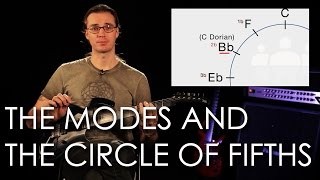Understanding Modes
Published on 26 January 2016
For more information from the source site of this video please visit: http://secretguitarteacher.com/youtube/advanced/theory/mTHZjAG1auc/84429435-understanding-modes.php
Here is the abridged transcript:
In theory, any type of scale can have its modes, but we are going to focus on the C Major scale. Mode number 1 is called the Ionian mode after the name of an ancient Mediterranean tribe who inhabited a region in what is now western turkey. 'In' is to remind us of 'I' for 'Ionian'. Notice that in the notes column we simply have the familiar CDEFGABC the notes of the C Major scale. Mode number 2 of the C major scale is called the D Dorian mode. 'Dorset' starts with 'D' for 'Dorian'. You can see the D Dorian mode contains the notes of the C Major scale from the 2nd note to the 9th. The Dorians were an ancient tribe who settled in a place called Doris in what is now central Greece around 1100 B.C. The 3rd mode of the scale of C Major is the E Phrygian mode. For 'P for Phrygian' we add the word 'People' to our mnemonic. The notes of the E Phrygian mode are EFGABCD and E the C major scale from the 3rd to the 10th note. Phrygia was an ancient country situated between the Black sea and the Mediterranean between the 12th and 6th centuries BC. Next is the F Lydian mode. Our mnemonic now reads 'In Dorset People Live' and the notes of the F Lydian mode are FGABCDEF, the notes of the C major scale from note 4 to note 11. Lydia was an Iron age kingdom just east of Ionia in what is now a province of Turkey. The fifth mode of the C Major scale is the G Mixolydian mode. 'M' for 'mostly' reminding us of 'M' for 'Mixolydian'. The notes GABCDEFG are the C major scale from notes 5 to 12. The word derives from the greek and means literally half-lydian. Mode 6 of the C major scale is the A Aeolian mode. 'A' for 'along' reminding us of 'A' for 'Aeolian'. The notes are ABCDEFGA being notes 6 to 13 in the C major scale. Remember we have looked at this as the relative minor scale. The Aeolians were an ancient Greek tribe who took their name from Aeolus the ancient Greek God of the Wind. The B Locrian Mode. 'L' for 'lanes' reminding us of 'L' for 'Locrian'.The B locrian scale contains the notes of the C Major scale from 7 to 15. The name refers to yet another ancient Greek tribe the Locrians who lived in Locris pretty much next door to Doris where the Dorians lived.
Exactly the same process can be applied to any Major scale to work out its modes. However, in usage, it is generally more useful to know the modes directly. So we need to take another view of modes to help simplify this task.
Looking at the Ionian mode we compare the notes to those of the Major scale of the same name. This is shown in this chart under the heading Home scale. We can see that in this case there is no difference. So under the heading comparison we put the word same. For the next mode, the D Dorian mode we compare the notes to the home scale of D Major. You can see from the top of the picture that the Dorian mode has two notes that differ from the Major scale. The 3rd and 7th notes of the D Major scale are both flatted to make the D Dorian mode. So in the comparison column we have the formula b3, b7. For the E Phrygian mode we compare the notes to the home scale of E Major. You can see from the top of the picture that the Phrygian mode has four notes that differ from the Major scale. The 2nd 3rd 6th and 7th notes of the E Major scale are all flatted to make the E Phrygian mode. So in the comparison column we have the formula b2, b3, b6, b7. For the F Lydian mode we compare the notes to the home scale of F Major. The Lydian mode has one note that differs from the Major scale. The 4th note of the F Major scale is sharped to make the F Lydian mode. So in the comparison column we have the formula #4. For the G Mixolydian mode we compare the notes to the home scale of G Major. You can see that the Mixolydian mode also has just one note that differs from the Major scale. The 7th note of the G Major scale is flatted to make the G Mixoydian mode. So in the comparison column we have the formula b7. For the A Aeolian mode we compare the notes to the home scale of A Major. The Aeolian mode has three notes that differ from the Major scale. The 3rd,6th and 7th notes of the A Major scale are all flatted to make the A Aeolian mode. So in the comparison column we have the formula b3, b6 and b7. For the B Locrian mode we compare the notes to the home scale of B Major. You can see that the Locrian mode has five notes that differ from the Major scale. The 2nd,3rd, 5th,,6th and 7th notes of the B Major scale are all flatted to make the B Locrian mode. So in the comparison column we have the formula b2, b3, b5, b6 and b7.
 Learn Chord Theory In No Time
Learn Chord Theory In No Time
 Intervals on the Guitar Fret Board
Intervals on the Guitar Fret Board
 EAR TRAINING: The Golden Rules of Accompaniment
EAR TRAINING: The Golden Rules of Accompaniment
 Beginner Lesson - Barre Chord Basics and the E Sha...
Beginner Lesson - Barre Chord Basics and the E Sha...
 Killer Shred Technique
Killer Shred Technique
 3 Intermediate Fingerstyle Rhythm Patterns - Guita...
3 Intermediate Fingerstyle Rhythm Patterns - Guita...
 How to actually USE the CAGED system on guitar. A...
How to actually USE the CAGED system on guitar. A...
 4. The Modes and the Circle of Fifths
4. The Modes and the Circle of Fifths
 Guitar Lesson: The Major Scale - Ionian Mode
Guitar Lesson: The Major Scale - Ionian Mode
 Lydian Mode: Part 2 - Modal Progressions
Lydian Mode: Part 2 - Modal Progressions







